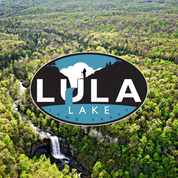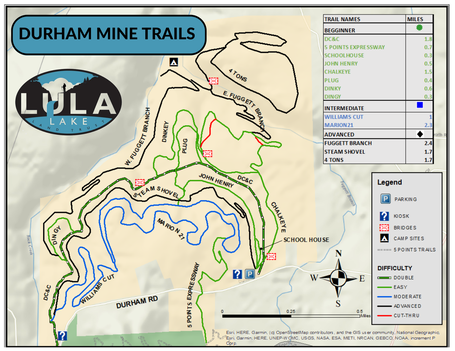Durham Mine Trails
|
Click Map for PDF download.
Full trail descriptions are listed below. |
Lula Lake Land Trust’s Durham Property is one of Lookout Mountain’s oldest communities. The Durham Mines were known to be active coal mines between the years of 1860-1924 (circa) with some in the Ascalon area being active until about 1950. At one time, the town of Durham was said to have a workforce of about 30,000 people; had electricity before Chattanooga, and even had a movie theater and commissary. In May of 2019, LLLT purchased approximately 486 acres of the Durham mining community just north of 5 Points.
LLLT Land Manager Patrick Kelly began surveying this newly purchased piece of land. The Durham Mind Trails was previously used to provide progress after coal-mining, but it was abandoned after the mining resources were exhausted. The land has healed from its previous use and now boasts a flourishing ecosystem. What once was a coal-mining community is now home to a healthy population of flora and fauna—Pink Lady Slippers, wild turkeys, and Pileated Woodpeckers are often seen frequently in the spring. Durham Mine Trails were made possible thanks to the generous support of both Riverview Foundation and REI Co-op. These critical funds helped Lula Lake Land Trust build a 15-mile trail system open to the community daily. |
Access Details:
LLLT now has a backcountry campsite located at the Durham Mine Trails. This remote campsite is located off the E. Fuggett Branch trail and is a minimum of a 1.6-mile hike from the Durham Mine Trailhead. Reservations are required and there is a $5 per person fee. There is currently one campsite and has a capacity for four tents. We hope to open two more campsites and a moldering privy inthe future.
FOR CAMPING, CLICK BELOW FOR ONLINE RESERVATION SYSTEM.
- The Durham Mine Trails parking lot is open to the public from dawn until dusk everyday - reservations are NOT required!
- There is a $5 fee per vehicle.
- If you have a Lula Lake Annual Pass (for access to our Core Preserve on Open Gate Days) or a Cloudland Canyon Parking Pass, it includes parking at the Durham Mine Trails. Be sure to have it hanging in your vehicle.
- GPS Coordinates: 34°51'55.4"N 85°25'08.5"W or click here for Google directions.
- Accessible parking and bathroom (privy) amenities
LLLT now has a backcountry campsite located at the Durham Mine Trails. This remote campsite is located off the E. Fuggett Branch trail and is a minimum of a 1.6-mile hike from the Durham Mine Trailhead. Reservations are required and there is a $5 per person fee. There is currently one campsite and has a capacity for four tents. We hope to open two more campsites and a moldering privy inthe future.
FOR CAMPING, CLICK BELOW FOR ONLINE RESERVATION SYSTEM.
Rules and Regulations:
- NO roadside parking
- NO motorized vehicles
- NO equestrian use
- Stay on marked trails only
- Respect private property boundaries
- Trails may be closed due to weather - please do not ride on muddy trails
- Pets must be on leash and picked up after
- Removal of plants and vegetation is prohibited
- Camping is limited to designated areas and reservations must be made by emailing [email protected]
- No fossil digging unless coordinated through Lula Lake Land Trust
Recreation Overview:
Trail Details:
- Durham has 15 miles of trails encompass hiking and mountain biking for all skill levels
- The trails make a great place for first time hikers and mountain bikers, offering up to 8 miles of beginner-friendly trails
- Over 8 miles of trail were designed with adaptive cyclists in mind (trails DC&C, Chalkeye, Marion 21, Dinky, Dingy, John Henry, & 5 Points Expressway), and adaptive mountain bike trail guidelines can be found here
- There are 5.5 miles of advanced trails to challenge hikers, runners, and cyclists
- Backcountry campsites available through reservation-only by emailing [email protected]
- Trails give access to Rock Creek and Fuggett Branch.
- USER CAUTION: Trail signage is still being installed — be sure to bring the map and explore with caution!
Trail Details:
- DC&C- (1.8 Miles, Beginner): DC&C is the double track trail that runs through the heart of the property. This flat trail is an abandoned railroad line and will connect to every trail in the system. This trail is ideal for first time hikers and mountain bikers.
- John Henry (0.5 mile, Beginner): John Henry is a short trail is full of rollers and is ideal for the first time mountain biker.
- Steam Shovel (1.7 miles, Advanced): Steam Shovel has short steep grades, berms, and a few hidden jump lines. It is recommended that you start from the parking area and head west. This trail is not recommended for hikers.
- Marion 21 (2.3 miles, Intermediate): Marion 21 is an easy to moderate trail that starts off with double track climbs then fades into rolling single track. This trail will lead you to the top of Williams Cut and connects to the 5 Points Expressway.
- Chalkeye (1.5 miles, Beginner): Chalkeye is rolling single track with great views of Fuggett Gulch. you will see two universally designed cut through trails that bypass the tight single track trail. This trail will also connect you to the Fuggett Branch trail and the Plug trail. If you start and end at the parking lot this lollipop loop will be a two-mile loop.
- School House (0.25 miles, Beginner): School House is to test your skills on wooden and natural features. It provides jumps, drops and skinny’s and can be ridden as a loop with the John Henry trail. This trail is not open to hikers.
- Fuggett Branch (2.10 miles, Advanced): Fuggett Branch descends 260ft into Fuggett Gulch, traversing East and West. There is a spur trail that will take you Rock Creek and designated campsites. Fuggett Branch trail will also connect you to the 4 Tons trail.
- 4 Tons (1.7 miles, Advanced): 4 Tons starts and ends with a 250 ft climb in less than a quarter mile. At the top you will find technical rock features and some great views of Fuggett Gulch. It is best ridden clockwise and makes for a strenuous hike.
- Williams Cut (1 mile, Intermediate): Williams Cut is a moderate trail with some rock features and makes for a good climb or descent. It can be accessed from Marion 21 or at the end of Steam Shovel.
- 5 Points Expressway (0.7 mile, Beginner): 5 Points Expressway starts off the Marion 21 trail and will take you to the CCT in the 5 points area. The trail crosses the road to access 5 Points.
- Dingy (0.3 mile, Beginner): Dingy is a spur loop, double-track trail with minimal grades that branches off the DC&C trail.
- Dinky ( 0.6mile, Beginner): Dinky is a loop that branches off the DC&C trail and ends at the start of the Fuggett Branch trail.

Don't just visit... make a difference!
Did you know that Lula Lake is preserved through donations from generous supporters? These Heroes on Conservation are responsible for preserving the natural beauty that will take your breath away during your visit. Through support of donations, we have helped protect 12,000 acres for going on 26 years. Find out how you can make a difference by visiting our webpage here or emailing our Director of Development, Matthew, at [email protected].
Did you know that Lula Lake is preserved through donations from generous supporters? These Heroes on Conservation are responsible for preserving the natural beauty that will take your breath away during your visit. Through support of donations, we have helped protect 12,000 acres for going on 26 years. Find out how you can make a difference by visiting our webpage here or emailing our Director of Development, Matthew, at [email protected].

